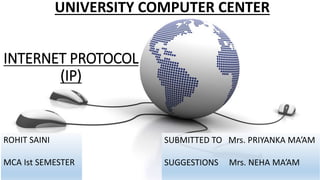
Internet protocols
- 1. INTERNET PROTOCOL (IP) ROHIT SAINI MCA Ist SEMESTER UNIVERSITY COMPUTER CENTER SUBMITTED TO Mrs. PRIYANKA MA’AM SUGGESTIONS Mrs. NEHA MA’AM
- 2. What is Protocol… standard set of regulations and requirements that allow two electronic items to connect to and exchange information with one another. Used to describe how devices can communicate Protocols exist at several levels in a telecommunication connection
- 3. What is IP……? IP stands for Internet Protocol Internet Protocol (IP) is the principal set of digital message formats and rules for exchanging messages between computers IP specifies the format of packets, also called datagrams, and the addressing scheme.
- 4. What is IP……? (cont.) IP by itself is something like the postal system. It allows you to address a package and drop it in the system, but there's no direct link between you and the recipient.
- 5. Purpose of IP….. Need a standard means of communication between devices The main purpose and task of IP is the delivery of datagrams from the source host (source computer) to the destination host (receiving computer) based on their addresses
- 6. Construction of Datagrams…. Each datagram has two components Header Payload Header + Data (Payload) Packet
- 7. IP Address An IP address is a unique global address for a network interface is a 32 bit long identifier encodes a network number (network prefix) and a host number 1000111110000000 10001001 10010000 1st Byte = 128 2nd Byte = 143 3rd Byte = 137 4th Byte = 144 128.143.137.144
- 8. IP Service Delivery service of IP is minimal. IP provides an unreliable connectionless best effort service Unreliable : IP doesn’t make an attempt to recover lost packets Connectionless : Each packet is handled independently Best Effort : IP doesn’t make guarantees on the service ( No through output , No delay guarantee…)
- 9. IP Service (Cont.…) IP supports the following services One-to-one (unicast) One-to-several (multicast) One-to-all (broadcast) unicast broadcastmulticast
- 10. Journey to IP Versions… IPV(1-3) : were not formally assigned. IPV4 : TCP/IP , 32bit IP address currently used. IPV5 : Internet Stream Protocol (SP) • Experimental Protocol • Never Introduced for public use. IPV6 : Designed to replace IPV4 , 128bit IP address
- 11. IPv4 ADDRESSES 4th version in the development of the Internet Protocol. 32 bit address. Uniquely defines the connection of a device to the Internet.
- 12. Address Space Address Space of IPv4 is 232 or 4,294,967,296
- 13. Written using binary notation. For, convenience the address are usually written using dotted decimal notation. 10000000 00001011 00000011 00011111 128.11.3.31 Address Notation
- 14. Class Ranges of Internet Addresses
- 15. Class A Class A addresses are assigned to networks with a very large number of hosts The high-order bit in a class A address is always set to zero. The next seven bits (completing the first octet) complete the network ID. The remaining 24 bits represent the host ID.
- 16. Class B Class B addresses are assigned to medium-sized to large-sized networks. The two high-order bits in a class B address are always set to binary 1 0. The next 14 bits complete the network ID. The remaining 16 bits represent the host ID.
- 17. Class C Class C addresses are used for small networks. The three high-order bits in a class C address are always set to binary 1 1 0. The next 21 bits complete the network ID. The remaining 8 bits represent the host ID.
- 18. Class D & E Class D addresses are reserved for IP multicast addresses. The four high-order bits in a class D address are always set to binary 1 1 1 0. The remaining bits are for the address that interested hosts recognize. Class E is an experimental address that is reserved for future use The high-order bits in a class E address are set to 1111.
- 19. Class Ranges of Network IDs… The network ID cannot begin with the number 127. The number 127 in a class A address is reserved for internal loopback functions. All bits within the network ID cannot be set to 1. All 1's in the network ID are reserved for use as an IP broadcast address. Address Class First Network ID Last Network ID Class A 1.0.0.0 126.0.0.0 Class B 128.0.0.0 191.255.0.0 Class C 192.0.0.0 223.255.255.0
- 20. Features of IPV4… Connectionless protocol and best effort based. Simplicity • It is simpler and easy to remember • Require less memory Familiarity • Millions of devices are already knowing it • Existing infrastructure already support it
- 21. Benefits of IPV4…. Widely support Shorter & Sweeter (header) Support of all Operating Systems All commonly used protocols are supported
- 22. Shortcoming of IPV4…. IPV4 specification didn’t identify any security mechanism. Millions of class A addresses are wasted. Many class B addresses also wasted. Not so many organizations are so small to have a class C block. Class E addresses were reserved for future purposes.
- 23. IPV4 Supporting Devices.. PCs Servers Modems Routers Printers Cameras Smart Phones Tablets & Gaming Systems Just about anything else connecting to the Internet
- 24. Why IPV6…..? IPV6 provides a platform on new internet functionality that will be needed in the immediate future and provide flexibility for future growth and expansion.
- 25. Benefits of IPV6….. IPV6 New header format Large address space Built in Security Extensibility Better support for QoS Efficient & hierarchical addressing and routing infrastructure
- 26. IP Based Technologies.. Internet VoIP IP – TV IP-VPN Wireless Mobile Technology Internet Broadcasting Multihoming
- 27. ANY QUERIES?
